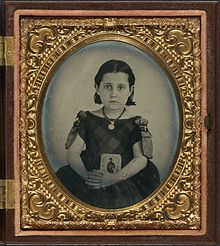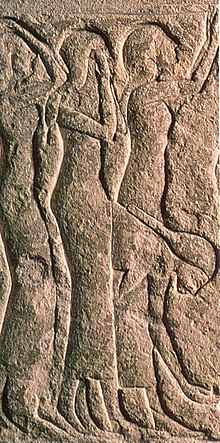
Back حداد Arabic Yas Azerbaijani عزا تؤرنی AZB Žielava BAT-SMG Траур Bulgarian Truchlení Czech Trauer German Πένθος Greek Malĝojo Esperanto Luto Spanish



Mourning is the expression[2] of an experience that is the consequence of an event in life involving loss,[3] causing grief.[2] It typically occurs as a result of someone's death, often (but not always) someone who was loved,[3] although loss from death is not exclusively the cause of all experience of grief.[4]
The word is used to describe a complex of behaviours in which the bereaved participate or are expected to participate, the expression of which varies by culture.[2] Wearing black clothes is one practice followed in many countries, though other forms of dress are seen.[5] Those most affected by the loss of a loved one often observe a period of mourning, marked by withdrawal from social events and quiet, respectful behavior in some cultures, though in others mourning is a collective experience.[6] People may follow religious traditions for such occasions.[6]
Mourning may apply to the death of, or anniversary of the death of, an important individual such as a local leader, monarch, religious figure, or member of family. State mourning may occur on such an occasion. In recent years, some traditions have given way to less strict practices, though many customs and traditions continue to be followed.[7]
Death can be a release for the mourner, in the case of the death of an abusive or tyrannical person, or when death terminates the long, painful illness of a loved one. However, this release may add remorse and guilt for the mourner.
- ^ Loés, João (22 February 2013). "A volta de Dom Pedro I". istoe.com.br (in Portuguese). Retrieved 7 November 2022.
- ^ a b c Robben, Antonius C. G. M. (4 February 2009). Robben, Antonius C. G. M. (ed.). Death, Mourning, and Burial A Cross-Cultural Reader (Ebook). Wiley. p. 7. ISBN 9781405137508. Retrieved May 28, 2021.
In Death, Mourning, and Burial, an indispensable introduction to the anthropology of death, readers will find a rich selection of some of the finest ethnographic work on this fascinating topic...
- ^ a b Brennan, Michael (14 January 2009). Mourning and Disaster Finding Meaning in the Mourning for Hillsborough and Diana (Ebook). Cambridge Scholars Publications (published 2008). p. 2. ISBN 9781443803793. Retrieved May 28, 2021.
The Hillsborough stadium disaster of 15 April 1989 and the death of Princess Diana on 31 August 1997 sparked expressivist scenes of public mourning hitherto unseen within the context of British society...
- ^ Hugstad, Kristi (July 26, 2017). "Grieving Losses Other Than Death". www.huffpost.com. Archived from the original on May 28, 2021. Retrieved May 28, 2021.
- ^ "Mourning | Grief, Rituals & Traditions | Britannica". www.britannica.com. 2024-08-19. Retrieved 2024-09-07.
- ^ a b Wilson, John Frederick (2023-01-25). "Death and dying: how different cultures deal with grief and mourning". The Conversation. Retrieved 2024-09-07.
- ^ Rusu, Mihai Stelian (2020-01-01). "Nations in black: charting the national thanatopolitics of mourning across European countries". European Societies. 22 (1): 122–148. doi:10.1080/14616696.2019.1616795. ISSN 1461-6696.